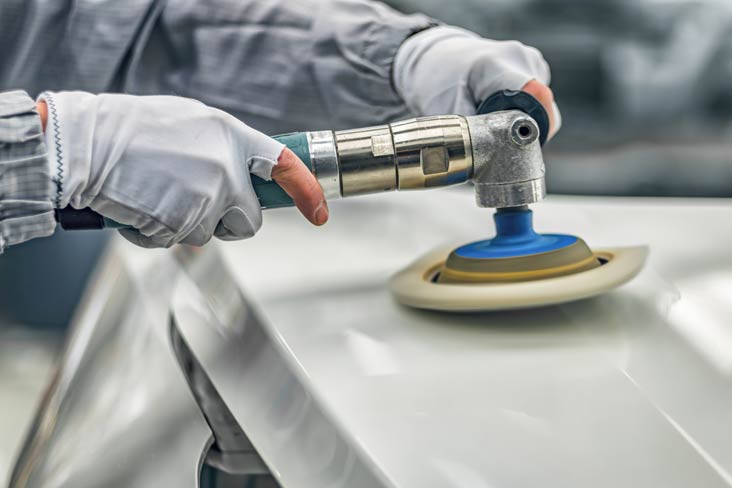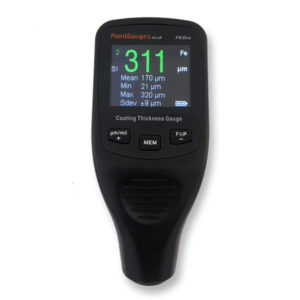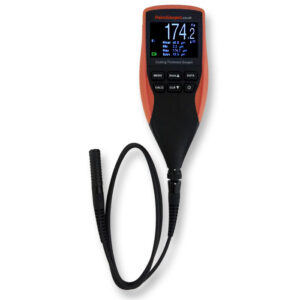Paint thickness gauges are an important tool in the paint inspection and correction process. Our FN Pro, FN Plus, FN Evo, FN CM, and 156 USB paint thickness gauges are suitable for this purpose and are used by professional detailers and paint correction specialists.
Why use a paint thickness gauge for detailing?
If defects such as scratches, swirls or other imperfections are to be removed from paint, an abrasive is typically used to remove the surface layer of paint or clear coat. This can be in the form of abrasive paper or an abrasive polishing compound, typically via a dual action or rotary machine polisher.

Before beginning the polishing process, it is important to assess and map the thickness of the paint across the areas to be polished. This allows the user to assess safe thresholds for material removal and identify and potential prior repairs. Likewise, measurements can be taken during the polishing process to assess levels of paint removal (which can vary based on different paint hardnesses and polishing compounds and equipment).
The risk of beginning to polish paint or continuing to polish paint without undertaking such measurements risks striking through the paint and requiring an expensive respray. For example, removing too much clear coat can strike through to the underlying colour coat or even leave such a thin layer of clear coat that it fails and subsequently flakes off. If polishing paint without a clear coat, such as cellulose paint, the risk is of striking through to the underlying primer coat or even the substrate metal.
The process of mapping a panel or vehicle can be eased and sped up by using a gauge that has a memory feature, allowing readings to be automatically be stored. The majority of our paint thickness gauges feature a memory function.
Paint thickness gauges for detailing
It is important that a gauge used for paint correction has appropriate consistency between readings and measurement resolution.
Low specification gauges are not suitable for detailing purposes and use during machine polishing of paints. They may produce erratic readings that lack consistency, meaning the user cannot assess the level of paint that has been removed during the polishing process. Likewise, an appropriate reading resolution is required to be able to determine levels of material removal. Low specification gauges may read to a resolution of no less than 10 micrometres or worse.
Our paint thickness gauges measure to a resolution of 1μm (micrometre = one one-thousandth of a millimetre) or on our flagship FN CM model, to an even higher resolution of 0.1μm.
Versatility across different car bodies
Detailers work on cars with both steel and aluminium bodies. Measuring paint thicknesses on these metals requires different technology. Some low specification gauges can measure on steel but not aluminium and vice-versa.
All of our paint thickness gauges can measure paint thicknesses on both steel and aluminium car bodies, through magnetic induction and eddy current technologies respectively. Furthermore, the gauges automatically detect the substrate type without the user needing to switch between modes.
Ergonomics important
Portable, handheld, lightweight paint thickness gauges are necessary given the mobile nature of most detailers work and the range of surfaces that they need to be used on.
Likewise, compactness provides for the ability for the user to slip the gauge in or out of a pocket during work.
Built-in sensor probes and an automatic measurement function allows for one-handed usage, which can be particularly useful when measuring at awkward angles or when reaching across bodywork. Our paint thickness gauges have these features.
The anatomy of car paint
Modern automotive paint systems are multi-layer and typically involve application of a primer, followed by a colour coat, followed by a clear coat. A detailer looking to correct swirls and surface scratches will typically be working on polishing the clear coat layer.
-
 FN Evo Coating Thickness Gauge£199.99
FN Evo Coating Thickness Gauge£199.99 -
 FN Ext Coating Thickness Gauge£299.99
FN Ext Coating Thickness Gauge£299.99
